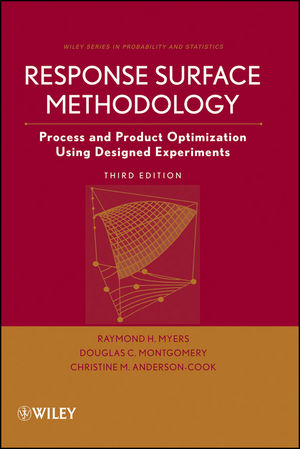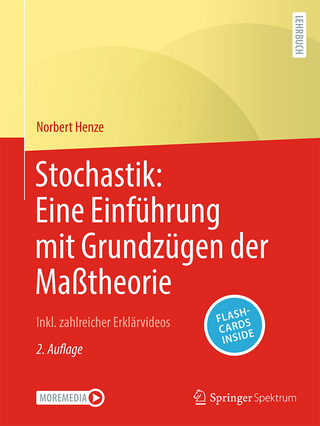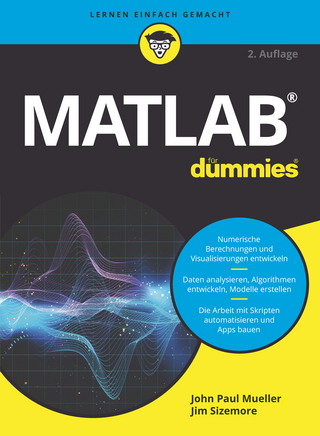
Response Surface Methodology
Wiley-Blackwell (Verlag)
978-0-470-17446-3 (ISBN)
- Titel ist leider vergriffen;
keine Neuauflage - Artikel merken
Praise for the Second Edition: "This book [is for] anyone who would like a good, solid understanding of response surface methodology. The book is easy to read, easy to understand, and very applicable. The examples are excellent and facilitate learning of the concepts and methods." -Journal of Quality Technology Complete with updates that capture the important advances in the field of experimental design, Response Surface Methodology, Third Edition successfully provides a basic foundation for understanding and implementing response surface methodology (RSM) in modern applications. The book continues to outline the essential statistical experimental design fundamentals, regression modeling techniques, and elementary optimization methods that are needed to fit a response surface model from experimental data. With its wealth of new examples and use of the most up-to-date software packages, this book serves as a complete and modern introduction to RSM and its uses across scientific and industrial research. This new edition maintains its accessible approach to RSM, with coverage of classical and modern response surface designs.
Numerous new developments in RSM are also treated in full, including optimal designs for RSM, robust design, methods for design evaluation, and experiments with restrictions on randomization as well as the expanded integration of these concepts into computer software. Additional features of the Third Edition include:* Inclusion of split-plot designs in discussion of two-level factorial designs, two-level fractional factorial designs, steepest ascent, and second-order models* A new section on the Hoke design for second-order response surfaces* New material on experiments with computer models* Updated optimization techniques useful in RSM, including multiple responses* Thorough treatment of presented examples and experiments using JMP 7, Design-Expert Version 7, and SAS software packages* Revised and new exercises at the end of each chapter* An extensive references section, directing the reader to the most current RSM research Assuming only a fundamental background in statistical models and matrix algebra, Response Surface Methodology, Third Edition is an ideal book for statistics, engineering, and physical sciences courses at the upper-undergraduate and graduate levels.
It is also a valuable reference for applied statisticians and practicing engineers.
Raymond H. Myers, PhD, is Professor Emeritus in the Department of Statistics at Virginia Polytechnic Institute and State University. He has over forty years of academic experience in the areas of experimental design and analysis, response surface analysis, and designs for nonlinear models. A Fellow of the American Statistical Society, Dr. Myers has authored or coauthored numerous journal articles and books, including Generalized Linear Models: With Applications in Engineering and the Sciences, also published by Wiley. Douglas C. Montgomery, PhD, is Regents' Professor of Industrial Engineering and Statistics at Arizona State University. Dr. Montgomery has over thirty years of academic and consulting experience and has devoted his research to engineering statistics, specifically the design and analysis of experiments. He has authored or coauthored numerous journal articles and twelve books, including Generalized Linear Models: With Applications in Engineering and the Sciences; Introduction to Linear Regression Analysis, Fourth Edition; and Introduction to Time Series Analysis and Forecasting, all published by Wiley. Christine M. Anderson-Cook, PhD, is Project Leader a t the Los Alamos National Laboratory, New Mexico. Dr. Anderson-Cook has over ten years of academic and consulting experience and has written numerous journal articles on the topics of design of experiments and response surface methodology.
Preface xi 1 Introduction 1 1.1 Response Surface Methodology, 1 1.2 Product Design and Formulation (Mixture Problems), 10 1.3 Robust Design and Process Robustness Studies, 10 1.4 Useful References on RSM, 11 2 Building Empirical Models 13 2.1 Linear Regression Models, 13 2.2 Estimation of the Parameters in Linear Regression Models, 14 2.3 Properties of the Least Squares Estimators and Estimation of s2, 22 2.4 Hypothesis Testing in Multiple Regression, 24 2.5 Confidence Intervals in Multiple Regression, 31 2.6 Prediction of New Response Observations, 35 2.7 Model Adequacy Checking, 36 2.8 Fitting a Second-Order Model, 47 2.9 Qualitative Regressor Variables, 55 2.10 Transformation of the Response Variable, 58 3 Two-Level Factorial Designs 73 3.1 Introduction, 73 3.2 The 22 Design, 74 3.3 The 23 Design, 86 3.4 The General 2k Design, 96 3.5 A Single Replicate of the 2k Design, 96 3.6 The Addition of Center Points to the 2k Design, 109 3.7 Blocking in the 2k Factorial Design, 114 3.8 Split-Plot Designs, 121 4 Two-Level Fractional Factorial Designs 135 4.1 Introduction, 135 4.2 The One-Half Fraction of the 2k Design, 136 4.3 The One-Quarter Fraction of the 2k Design, 148 4.4 The General 2k2p Fractional Factorial Design, 154 4.5 Resolution III Designs, 158 4.6 Resolution IV and V Designs, 167 4.7 Fractional Factorial Split-Plot Designs, 168 4.8 Summary, 172 5 Process Improvement with Steepest Ascent 181 5.1 Determining the Path of Steepest Ascent, 182 5.2 Consideration of Interaction and Curvature, 189 5.3 Effect of Scale (Choosing Range of Factors), 193 5.4 Confidence Region for Direction of Steepest Ascent, 195 5.5 Steepest Ascent Subject to a Linear Constraint, 198 5.6 Steepest Ascent in a Split-Plot Experiment, 202 6 The Analysis of Second-Order Response Surfaces 219 6.1 Second-Order Response Surface, 219 6.2 Second-Order Approximating Function, 220 6.3 A Formal Analytical Approach to the Second-Order Model, 223 6.4 Ridge Analysis of the Response Surface, 235 6.5 Sampling Properties of Response Surface Results, 242 6.6 Multiple Response Optimization, 253 6.7 Further Comments Concerning Response Surface Analysis, 264 7 Experimental Designs for Fitting Response Surfaces-I 281 7.1 Desirable Properties of Response Surface Designs, 281 7.2 Operability Region, Region of Interest, and Model Inadequacy, 282 7.3 Design of Experiments for First-Order Models, 285 7.4 Designs for Fitting Second-Order Models, 296 8 Experimental Designs for Fitting Response Surfaces-II 349 8.1 Designs that Require a Relatively Small Run Size, 350 8.2 General Criteria for Constructing, Evaluating, and Comparing Experimental Designs, 362 8.3 Computer-Generated Designs in RSM, 386 8.4 Some Final Comments Concerning Design Optimality and Computer-Generated Design, 405 9 Advanced Topics in Response Surface Methodology 417 9.1 Effects of Model Bias on the Fitted Model and Design, 417 9.2 A Design Criterion Involving Bias and Variance, 420 9.3 Errors in Control of Design Levels, 432 9.4 Experiments with Computer Models, 435 9.5 Minimum Bias Estimation of Response Surface Models, 442 9.6 Neural Networks, 446 9.7 RSM for Non-Normal Responses-Generalized Linear Models, 449 9.8 Split-Plot Designs for Second-Order Models, 466 10 Robust Parameter Design and Process Robustness Studies 483 10.1 Introduction, 483 10.2 What is Parameter Design?, 483 10.3 The Taguchi Approach, 486 10.4 The Response Surface Approach, 495 10.5 Experimental Designs for RPD and Process Robustness Studies, 525 10.6 Dispersion Effects in Highly Fractionated Designs, 537 11 Experiments with Mixtures 557 11.1 Introduction, 557 11.2 Simplex Designs and Canonical Mixture Polynomials, 560 11.2.1 Simplex Lattice Designs, 560 11.3 Response Trace Plots, 576 11.4 Reparameterizing Canonical Mixture Models to Contain a Constant Term (b0), 577 12 Other Mixture Design and Analysis Techniques 589 12.1 Constraints on the Component Proportions, 589 12.2 Mixture Experiments Using Ratios of Components, 617 12.3 Process Variables in Mixture Experiments, 621 12.4 Screening Mixture Components, 641 Appendix 1 Moment Matrix of a Rotatable Design 655 Appendix 2 Rotatability of a Second-Order Equiradial Design 661 References 665 Index 677
| Reihe/Serie | Wiley Series in Probability and Statistics |
|---|---|
| Zusatzinfo | Illustrations |
| Verlagsort | Hoboken |
| Sprache | englisch |
| Maße | 179 x 259 mm |
| Gewicht | 1324 g |
| Themenwelt | Mathematik / Informatik ► Mathematik ► Wahrscheinlichkeit / Kombinatorik |
| ISBN-10 | 0-470-17446-3 / 0470174463 |
| ISBN-13 | 978-0-470-17446-3 / 9780470174463 |
| Zustand | Neuware |
| Haben Sie eine Frage zum Produkt? |
aus dem Bereich


